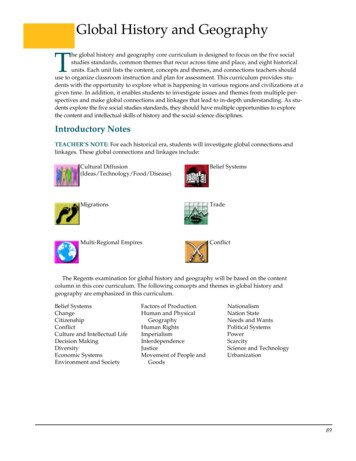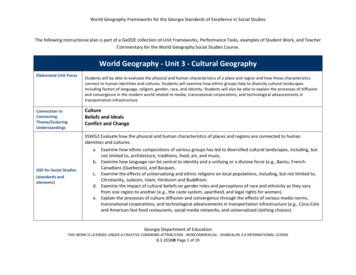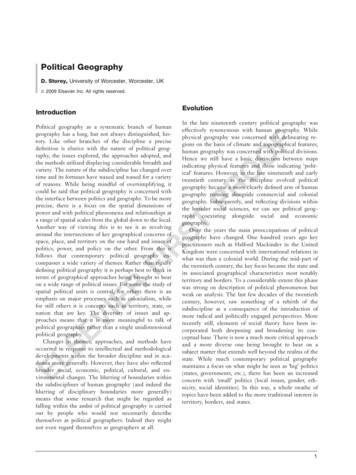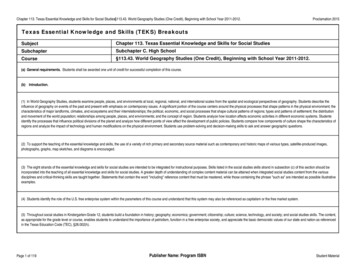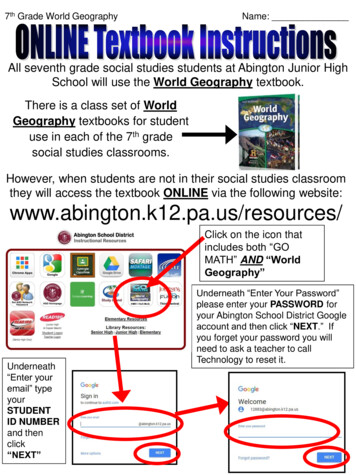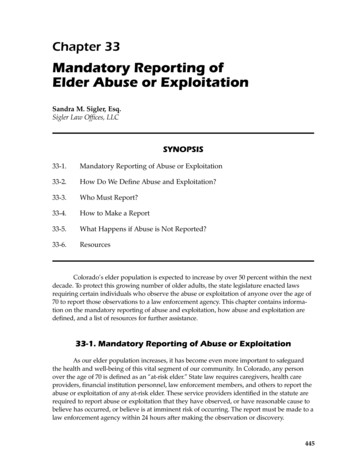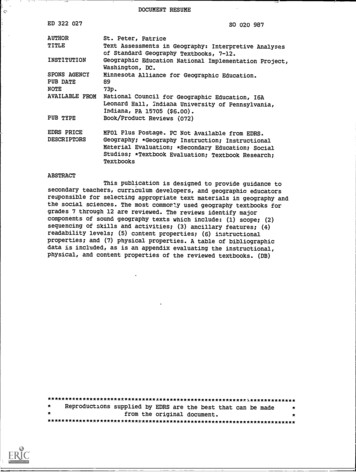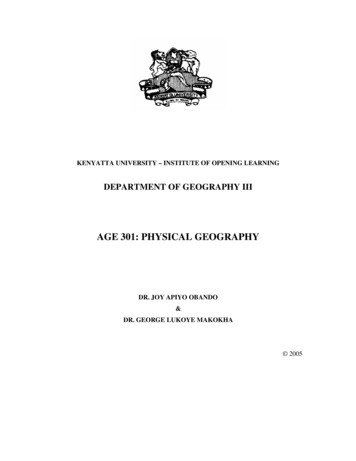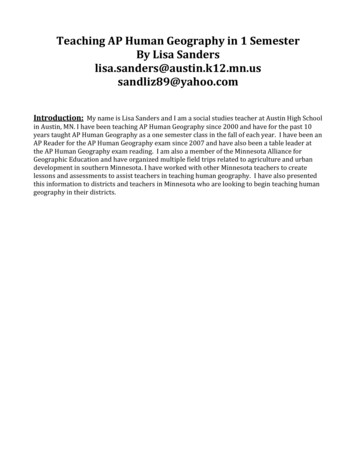
Transcription
Teaching AP Human Geography in 1 SemesterBy Lisa o.comIntroduction: My name is Lisa Sanders and I am a social studies teacher at Austin High Schoolin Austin, MN. I have been teaching AP Human Geography since 2000 and have for the past 10years taught AP Human Geography as a one semester class in the fall of each year. I have been anAP Reader for the AP Human Geography exam since 2007 and have also been a table leader atthe AP Human Geography exam reading. I am also a member of the Minnesota Alliance forGeographic Education and have organized multiple field trips related to agriculture and urbandevelopment in southern Minnesota. I have worked with other Minnesota teachers to createlessons and assessments to assist teachers in teaching human geography. I have also presentedthis information to districts and teachers in Minnesota who are looking to begin teaching humangeography in their districts.
Helpful Tips for Teaching AP Human Geography in 1 Semester1. Fall Semester is the Ideal Time to Teach This Course: Ideally, if teachers aregoing to teach this course in 1 semester, it would be best to teach it during the 1st/Fallsemester as this will ensure teachers have enough time to cover the AP Human Geographyconcepts in preparation for the AP Exam in May.2. AP Human Geography Curriculum: Teachers need to follow the AP HumanGeography course description and cover the materials listed in the course description. Myadvice to teachers is to make a list of the concepts that need to be covered for each unit anduse that to guide their curriculum development. Teachers need to be focused and be surethey cover all the concepts in the course description, which may mean changing how thecourse is taught and will require students to complete work outside of school. Teachers mayneed to look at utilizing a learning management system and/or flipped classroom strategies.3. AP Human Geography Exam Review Sessions: While teaching the course during1st/Fall Semester is the best for covering the concepts, it does result in a 3-4 month breakbetween covering the material in class and taking the AP Human Geography exam in May.To assist my students in preparing for the AP exam, I offer review sessions for my students.These review sessions begin 6 weeks before the AP exam and include 2 sessions (before andafter school) during the week and Saturday morning review sessions. I also provide mystudents with a calendar of which units will be covered during each review session and Icover the same content in the before and after school sessions – so that students can attendthe session that best fits in their schedule. By providing my students with a calendar, theyknow what concepts will be discussed during each review session so they can be preparedfor these sessions. It also provides my students with the opportunity to select those reviewsessions and content that the students need the most help with. While I encourage mystudents to attend all sessions, as it will assist them in preparing for the exam, they are notrequired to attend review sessions in order to take the AP exam.4. Teacher Resources: There are numerous resources available for AP Human Geographyteachers. The resources listed below provide information and resources to assist theteachers in teaching AP Human Geography.a. AP Human Geography Facebook site – This site has new information and resources ona daily basis, which geography teachers have generously shared.b. Ninth Graders and AP Human Geography Top Ten List: This is a column written bySharon Shelerud and is posted on the National Council for Geographic Educationwebsite. Sharon’s top 10 list column provides a wealth of information regarding howto set up an AP Human Geography course, key concepts to cover in each unit as wellas lists of great resources and videos to assist teachers in teaching AP HumanGeography. If you have not viewed her top 10 lists, I would encourage you to do so.Here is the link to Sharon Shelerud’s column: http://www.ncge.org/aphg-columns
5. Textbooks: If possible, allow students to keep their AP Human Geography textbooks untilthey take the AP Human Geography exam in May. This will provide students with theopportunity, if they choose so, to review any material in the textbook that they feel they needto review.6. Utilize a Learning Management System to provide students with access toclassroom materials: I have found that providing students with access to the coursecontent (Power Points, assignments, etc.) through a learning management system is veryvaluable as it provides students the opportunity to access this material whenever they needto. I have found this is a great resource for students who were absent and it has decreasedthe number of students asking for additional copies of assignments, calendar, etc. as theseitems are all online. As a teacher, you need to select the format that works best for you andworks with your district’s technology plan. I have utilized Moodle in the past but last yearmoved to utilizing Google Docs as it was more user friendly and my students were able toaccess it on their phones and were able to access any Power Points, assignments, etc.whenever they needed to. Other learning management systems include Schoology,Blackboard, D2L Brightspace and Google classroom. Some of these systems are free whileothers require a site license or district license. Teachers should contact their technologydepartment and administration regarding which format to utilize.7. History Background: My students will take AP Human Geography as 10th graders andhave previously taken World History as 9th graders (either Honors or regular). Ideally thisscope and sequence will provide my students with the historical background that will assistthem in learning Human Geography because in order to understand some geographicconcepts, students need to have an understanding of world history as well. If this is notpossible, teachers will need to incorporate world history into their teaching of HumanGeography in order to assist students understand the concepts being taught. Teachers mayalso need to incorporate aspects of United States history into their teaching of humangeography in order to assist students understand the concepts being taught.8. Summer Assignment: If teachers give their students a summer assignment, be sure towork with this assignment during the first week of school. Teachers will need to determinethe summer assignment that works best for their students. Over the summer, I mail a packetto all of my students who will be taking AP Human Geography in the fall. This packetincludes a map list of countries by continent and a packet of blank maps of the continents forthe students to use in preparing for their 100 country map test which they will take the firstweek of school. As students will be working with data from countries around the world, Ifeel it is important that they know where they located so they can start making connectionsregarding these countries and drawing conclusions regarding their similarities anddifferences. My students are also expected to complete a current events assignment in whichthey identify and describe 5 current events and explain which of the 5 themes of geographycan be applied to each current event. Students are also provided with readings on the 5
themes of geography to assist them in completing this assignment. My students will sharetheir current events in small groups and we will have a large group discussion of the 5themes of geography during the first week of school.9. Notes: Teachers will need to establish their own requirements and format for notes. I haveutilized guided reading questions for students to use as a guide to assist them in taking noteson their textbook reading. These questions are collected and graded but can also be used bystudents on quizzes throughout the unit. While I do not require students to take a specificform of notes, many like to use Cornell notes. If students are struggling with how to takenotes, teachers may need to share different note taking strategies with students at thebeginning of the semester and then allow students to use the strategy that works best forthem.10. Notebooks: My students are required to keep a 3-ring binder in which they organizeall their notes, vocabulary, class activities, etc. by unit. My students turn their notebooks inon the day of the test to be graded. Some teachers have utilized Interactive notebooks inwhich students take notes on specific aspects of the textbook on the right side of theirnotebook and then add in-class activities to the left side of their notebook. Teachers havealso used foldables which provide students with the opportunity to be creative and craftywhile gathering information about major geographic concepts such as the 3 agriculturalrevolutions, the different economic activities, types of agriculture, stages of the demographictransition model, etc. Students are able to display these concepts in a visual format thatmakes it easier to compare these concepts or aspects of these concepts.11. Vocabulary: Vocabulary is a key component to the study of Human Geography, asmany of the terms and concepts are new to students. Teachers need to determine whatworks best for their students regarding vocabulary. There are a variety of techniques andstrategies that teachers use for vocabulary flashcards, vocabulary charts, definitions, etc.Teachers need to make sure that they work with the vocabulary with their students in class.Vocabulary is a vital aspect of this course and it needs to be worked with on a daily basis.Students need to use vocabulary terms and work with them in class to describe the patterns,distributions, etc. they see in the data being presented to them.12. Expectations: Teaching AP Human Geography in one semester is not possible withoutrequiring students to complete homework outside of class. Teachers need to explain to theirstudents and parents that homework will be required in order to be successful in this class.Students will need to read their textbook and take notes outside of class. Students may alsoneed to view videos, read articles, gather data, etc. outside of class in preparation for in-classactivities.13. Flipped Classroom: Teaching AP Human Geography in one semester requiresteachers to utilize a variety of ways to teach this course. In order to cover all the conceptsand information in the AP Human Geography course description, teachers will need to asktheir students to complete work outside of class. Students may need to read and take notesfrom their textbook, view videos, read articles, gather data, etc. prior to class so they areprepared to participate in the daily activities. Students and parents need to be made awareof this and if students are not completing their activities outside of class, teachers need to
have conversations with these students regarding why they are not completing theirhomework. This course, being taught in a semester, requires open communication betweenthe teacher, students and parents. It is important that all people involved understand theexpectations of this course.14. Educannon: Educannon is a great resource that provides teachers with a variety ofways to utilize videos in their classroom. While videos are a great way to share content withstudents, it might not be possible to show videos in class when teaching AP HumanGeography in one semester. Teachers can embed questions into the videos they would liketheir students to view and students would need to answer these questions before they cancontinue viewing the video. This provides the teacher with the opportunity to ask studentsto view videos that contain information that will be utilized in a class discussion or used in aclass activity. I would encourage teachers to find short videos or podcasts that they wanttheir students to view in preparation for the in-class discussion and activity. I would cautionteachers about using videos that are over 15 minutes in length, as sometime quantitydecreases quality. Teachers will need to have a learning management system that theyutilize for their class and their students will need to have access to this in order access thesevideos. I would encourage teachers to assign these videos 2 – 3 days before students will beworking with them in class, to ensure that all students have the opportunity to access themas some students do not have internet access at home.
Calendar:List below is a rough outline of my calendar for teaching AP Human Geography during1st/Fall Semester of the 2015 – 2016 school year.Please also see example calendars to accompany this document.I use the following textbook: Rubenstein’s 11th Edition: “The Cultural Landscape: An Introduction to HumanGeography.”Unit 1: Geography: Its Nature and Perspectives Chapter 1 3 weeks (along with introduction to course, summer assignment discussion, 100country map test)Tentatively September 8 – 30, 2015Tests: (I have decided to split my tests into two days this year to ensure students haveenough time to complete the test without having to come in before or after school.This process will also provide test security for the free response questions – many ofwhich I use from past AP Exam – as the students would not see the test questions untilthe day they are taking the free response question test.)o Multiple Choice September 29th, 2015o Free Response Questions September 30th, 2015Unit 2: Population and Migration Chapters 2 – 3 3 weeksTentatively October 1 – 27, 2015 (with 4 day weekend in the middle of the month)Tests:o Multiple Choice October 27th, 2015o Free Response Questions October 28th, 2015Unit 3: Political Organization of Space Chapters 8 and 7 (last 2 sections) 2 weeksTentatively October 29 – November 10, 2015
Tests:o Multiple Choice and Free Response Questions November 10th, 2015Unit 4: Agricultural and Rural Land Use Chapter 10 1.5 weeksTentatively November 10 – 19, 2015Tests:o Multiple Choice and Free Response Quiz November 19th, 2015Unit 5: Industrialization and Economic Development Chapters 9, 11 2 weeksTentatively November 20 – December 9, 2015 (with 5 day weekend for Thanksgiving)Tests:o Multiple Choice December 8th, 2015o Free Response Questions December 9th, 2015Unit 6: Cities and Urban Land Use Chapters 12 – 13 1.5 – 2 weeksTentatively December 10 – 21, 2015Tests:o Multiple Choice December 18th, 2015o Free Response Questions December 21st, 2015Unit 7: Cultural Patterns and Processes Chapters 4 – 6, 7 (first 2 sections) 2 – 2 ½ weeksTentatively December 22 – January 15, 2016Tests:o Multiple Choice and Free Response Questions during Finals on January 13th,14th or 15th, 2016
Final Project: Introduced October 5th, 2015Due December 17, 2015Students are to apply geographic concepts to explain events in their community,events in another country in the world OR their family’s migrations and culture. Thisassignment requires students to apply the concepts they have learned throughout thiscourse and explain their significances at a personal, local or national level.If you have any questions or suggestions, please contact me at sandliz89@yahoo.com orlisa.sanders@austin.k12.mn.us
CALENDAR FOR UNIT 1 - CHAPTER 1: THINKING GEOGRAPHICALLY (2014 - 2015)DAYS1Tues. Sept. 2HOMEWORK DUEDAILY ACTIVITIES/LESSONSeating ChartTextbooksSyllabusHOMEWORK ASSIGNEDBring ID to classtomorrowASSIGNED READINGS2Weds. Sept. 3IDsRead and Take NotesAP HUG 11th Edition pg. 4 –133Thurs. Sept. 4Read first part of readingassignmentTextbooksWorld Map ActivityNotebook, Guided Reading,Vocabulary RequirementsWhat is Geography?GeoGuessrGlobal Grid PretestCh. 1 Vocabulary100 Country Map Test4Fri. Sept 55Mon. Sept. 8Summer Reading Chart – Beready to discuss6Tues, Sept. 97Weds. Sept.108Thurs. Sept.11Picture of Place Visit/LiveDiscussion of Summer ReadingAssignmentLatitude/Longitude ActivityMaps – projection, typesTODALSIGs Map Analysis ActivityDiscussion Toponyms, Site,SituationSite/Situation ActivityDiscussion RegionsRegions ActivityStudy for Map TestSummer ReadingAssignmentPattison, Robinson ArticleFinish TODALSIGs MapAnalysis Activity byFriday** Picture of PlaceVisit/LiveRead and take notesRead and take notesAP HUG 11thEdition pg. 14– 15Read and take notesAP HUG 11th Edition pg. 16– 19AP HUG 11th Edition pg. 22– 25
9Fri. Sept. 12Types of MapsDiscussion of DistributionDistribution Map AnalysisActivityGoogle Earth Pre-testGlobalizationDiscussion Types of DiffusionDiffusion Map Analysis ActivityGeothentic IntroductionSan Francisco Hospital Activity(Write Place)Geothentic Activity(Write Place)10Mon. Sept.1511Tues. Sept.1612Weds. Sept.1713Thurs. Sept.1814Fri. Sept. 19San Francisco Hospital Locationand ExplanationNotebooks DueVocabulary checkedGuided Reading QuestionsGradedShare Hospital LocationsSimilarities/DifferencesReview Unit 1Chapter 1 TestRead and take notesStudy for Chapter 1 Test*** Review Chat AP HUG8:00 p.m. on MoodleBe ready to share yourlocation in class onThursday*** Review Chat RCCHUG 8:00 p.m. onMoodleReview for TestStart reading Chapter 2AP HUG 11th Editionpg. 20 – 21, 26 – 29AP HUG 11th Edition pg. 12– 14
CALENDAR FOR UNIT 2 - CHAPTERS 2 - 3 Population, Migration: (2014 - 2015)DAYSHOMEWORK DUE1Weds. Sept.242Thurs. Sept.253Fri. Sept. 264Mon. Sept. 29Data on Assigned Country5Tues. Sept. 30DAILY ACTIVITIES/LESSONDiscussion EnvironmentalDeterminism, Possibilism,SustainabilityVideo: Guns, Germs, Steel # 1HOMEWORK ASSIGNEDRead and Take NotesFinish Video and Discuss itAnalyze Ch. 1 Test ResultsCh. 2 – 3 Vocab Group ActivityRead and Take NotesWorld Population DensityTypes of DensityAnalyze Density MapsPopulation Growth – StatisticsAnalyze world MapsAssign Country to gather info onPopulation PyramidsAnalyze countries and pyramidsCountry Analysis AssignmentDemographic Transition ModelRead and Take NotesGather info on AssignedCountryRead and Take NotesCountry AnalysisAssignmentRead and Take NotesFinish FoldableDemographic Transition ModelRead and Take NotesASSIGNED READINGSAP 11th Editionpg. 30 – 31, 34 - 37AP 11th EditionPg. 44 – 49AP 11th Edition pg. 50 – 53AP 11th Edition pg. 54 – 55AP 11th Edition pg. 56 – 57,64 - 696Weds. Oct 1Early ReleaseAP 11th Edition pg. 58 – 63,70 – 737Thurs. Oct. 28Fri. Oct. 3Factors Affecting Population –decline, overpopulation, etc.Analyze maps of data affectingpopulationRead and Take NotesAP 11th Edition pg. 78 – 91
Ravenstein’s Laws of MigrationTypes, Patterns of Migration9Mon. Oct. 6Types , Patterns MigrationRead and Take NotesAP 11th Edition pg. 92 – 9510Tues. Oct. 7Reasons for MigrationImmigration Policies11Weds. Oct. 813Fri. Oct. 10Immigration vs. Guest Workersvs. RefugeesReview for Test14Mon. Oct. 13Guided Reading Questions DueChapters 2 – 3 TestNotebook CheckPSAT Test Day16Weds. Oct. 15AP 11th Edition pg. 96 – 104History of Migration to and InU.S.Computer LabHistory of Migration to and inU.S. Computer lab12Thurs. Oct. 915Tues. Oct. 14Read and Take NotesAvian Flu ActivityFinish Guided ReadingQuestionsPut notebook in order forNotebook check
CALENDAR FOR UNIT 3 - CHAPTERS 4, 5, 6, 7 (1st 2 Sections) Cultural Geography: (2014 - 2015)DAYS1Weds. Oct. 22HOMEWORK DUE2Thurs. Oct. 23100% American3Fri. Oct. 24Analyze Your Country’sPopulation Paper DueDAILY ACTIVITIES/LESSON1. Unit 3 Introduction (Calendar,Review Questions, Vocabulary)2. Culture Discussion3. Folk vs. Popular CultureHOMEWORK ASSIGNEDChart on Folk vs. PopularCultureASSIGNED READINGSAP 11th Edition pg. 108 –125AP 11th Edition pg. 126 –1371. Folk vs. Popular Culture (Music,sports, clothing, food)2. Food Taboos3. Diffusion Folk and Popular Culture4. 100% American Activity1. What the World Eats ImageAnalysis for Folk Cultures,Popular Cultures (examples)4Mon. Oct. 271. Diffusion of folk and/or popularculture2. Sustainability of CultureFamily Food TraditionAssignment Due Nov. 7th5Tues. Oct. 28RampupWorkshop1. Language Types (families,branches, groups)2. Language Tree and Gallery Walkactivity (origin/hearth, diffusion,characteristics, connections)Map and Timeline ofOrigin and Diffusion ofEnglish, RomanceLanguages, IndoEuropean6Weds. Oct. 29RampupWorkshopCollege FairPeriods 2 – 61. Timeline, Map Activity English,Romance Languages, IndoEuropean languagesAP 11th Edition pg. 142 –157AP 11th Edition pg. 158 –177
7Thurs. Oct. 308Fri. Oct. 319Mon. Nov. 3PIGSEAR Collage Due onAssigned Country1. Dialects and Diversity inLanguagesAP 11th Edition pg. 182 –1991. Religion: Universalizing vs. Ethnic2. Gallery Walk of Religions (origin,diffusion, sacred space, burial,government policy)1. Gallery Walk of Religions (origin,diffusion, sacred space, burial,government policy)AP 11th Edition pg. 200 –22110Tues. Nov. 41. Ethnicity, Race and Racism in U.S.11Weds. Nov. 51. Review Chapters 4 – 6, 7.1-212Thurs. Nov. 613Fri. Nov. 7Notebook CheckCh. 4 – 6, 7.1-2 ReviewQuestions DueFamily Food TraditionPaper Due1. Test Chapters 4 – 6, 7.1-21. Share food traditionsAP 11th Edition pg. 226 –237Austin CollageAssignment Due FridayDecember 5thCultural CollageAssignment for yourassigned country DueFriday November 14thFamily Food Tradition
CALENDAR FOR UNIT 4 - CHAPTERS 8, 7 (last 2 sections): POLITICAL GEOGRAPHY (2014 - 2015)DAYS1Thurs. Nov.13HOMEWORK DUE 2Fri. Nov. 14 Political GeographyTerms defined,advantages anddisadvantagesidentified 3Mon. Nov. 17 4Tues. Nov. 185Weds. Nov.19 Centripetal vs.CentrifugalImage/CollageTypes ofGovernment,Governing States,Unitary vs. FederalStatesRedistrictingActivity DAILY ACTIVITIES/LESSONIntro to Political Geography Unit(Calendar, Vocabulary, ReviewQuestions)Video on Political GeographyEvolution of Modern StateHOMEWORK ASSIGNED Assigned PoliticalGeography Terms:Define, Advantages,DisadvantagesASSIGNED READINGS AP 11th pg. 260 – 261,264 - 281Gallery Walk/Class DiscussionPolitical Geography Terminology –Advantages, DisadvantagesDifferences between Colony andTerritoryDifference between Centripetal andCentrifugal ForcesDiscussion of 1 or 2 states Types of GovernmentChart, governingStates, Unitary vs.Federal StatesCentripetal vs.Centrifugal forcesimage AP 11th pg. 282 - 285Share centripetal vs. centrifugalimagesDiscussion types of government,governing states, unitary vs. federalstatesUS Land Distribution SystemsElectoral College and RedistrictingRedistricting ActivityGeopolitics: TheoriesUnited Nations Convention of theSeaAlliances: Types, Purposes, ConcernsKoreas: North vs. SouthVideo on North Korea Redistricting Activity(finish) AP 11th pg. 262 – 263,286 - 289 AP 11th pg. 238 - 255
6Thurs. Nov.207Fri. Nov. 21 EthnicCleansing/ConflictPresentations Due8Mon. Nov. 249Tues. Nov. 25 Chapter 7-8Notebook CheckDue Ethnic Cleansing/ConflictPresentations Ethnic Cleansing/ConflictPresentationsTerrorismFinish Terrorism DiscussionEthnic Distribution in USReviewChapter 7-8 Test Read and take notes Review for Test Final Project AP 11th pg. 290 - 295 AP 11th Ed pg. 226 237 Start Reading Chapter10
CALENDAR FOR UNIT 5 & 6 - CHAPTERS 9 - 11 Agricultural, Industrial Geography: (2014 - 2015)DAYS1Mon. Dec. 12Tues. Dec. 23Weds. Dec. 3HOMEWORK DUEDAILY ACTIVITIES/LESSONFinal Project SpecificsTopic Selections for Final ProjectIntroduction to Unit (Vocabulary, Calendar,Review Questions)Levels of Economic DevelopmentOrigins of Agriculture (10.1)Subsistence vs. Commercial Agriculture(foldable)- countries in it, % of labor force,machinery, farm size (10.1)Types of Agriculture (10.3)HOMEWORK ASSIGNEDASSIGNED READINGSAP 11th Ed. Ch. 10 pg. 344 –351Ch. 9 pg. 302AP 11th Ed. Ch. 10 pg. 356 –373AP 11th Ed. Ch. 10 pg. 352 3554Thurs. Dec. 4What the World Eats Picture AnalysisFood Consumption (10.2)AP 11th Ed. Ch. 10 pg. 374 –3795Fri. Dec. 5Economic Difficulties for FarmersVon Thunen Model (10.4)AP 11th Ed. Ch. 10 pg. 380 –3876Mon. Dec. 8Green Revolution (10.4)Sustainable AgricultureAP 11th Ed. Ch. 9 pg. 300 –313, 3407Tues. Dec. 9Classification of Countries (MDCs, LDCs)Core vs. Periphery (Wallerstein)HDI – characteristicsImpact of Gender on development (9.1 – 2)AP 11th Ed. Ch. 11 pg. 394 –397
8Weds. Dec.10Early Release DayIndustrial Revolution (11.1)Map World Industrial RegionsAP 11th Ed. Ch. 11 p. 398 –403, 408 – 4099Thurs. Dec.11Site v. Situation Factors for location ofFactories (11.2)10Fri. Dec. 12Types of FactoriesWeber’s Model (11.2)AP 11th Ed. Ch. 9 pg. 328 – 33911Mon. Dec. 15Paths to DevelopmentRostow’s Model (10.4)Fair TradeFinish DTM ChartTypes of Energy used in MDCs, LDCsIndicator of Development LevelAlternative forms of Energy (10.3)AP 11th Ed. Ch. 9 pg. 314 – 32713Weds. Dec.17Changes in Industrial Distribution in U.S.and World (11.2, 11.4)AP 11th Ed. Ch. 11 pg. 412 –41714Thurs. Dec.18Pollution (11.3)Review12Tues. Dec. 1615Fri. Dec. 19Austin Collage andReflection PaperDueCh. 9 – 11Notebook Check,Reading QuestionsEconomic Geography Test(Agriculture, Industry – Ch. 9 – 11)AP 11th Ed. Ch. 11 pg. 403 –407, 410 – 411, 418 – 424
16Mon. Dec. 2217Tues. Dec. 23Analyze Chapters 9 – 11 TestQuestions on Final ProjectWork Time for Final ProjectU.S. States and Capitals TestFinal Project DueJanuary 7thRelaxation TimeFinal Project due on Wednesday January 7th.As the end of the quarter is 7 days after this due date, it is important that you turn this in on time. As it’s a final project, you will not have anopportunity to make corrections to it.We will work on Chapters 12 and 13 when we return from break Urban Geography. Your test will be during Finals Week.Weds. January 14th – Finals for Periods 1, 2Periods 6, 8Thurs. January 15th – Finals for Periods 3, 4, 5Fri. January 16th – Finals for
CALENDAR FOR UNIT 7 - CHAPTERS 12 - 13: URBAN GEOGRAPHY (2014 - 2015)DAYS1Mon. Jan. 5HOMEWORK DUE 2Tues. Jan. 6Notes on Reading 3Weds. Jan. 7Final Project DueCentral Place TheoryReading and Model 4Thurs. Jan. 8 5Fri. Jan. 9Urban Land Use Models DAILY ACTIVITIES/LESSONReview Final Project DirectionsTests Analysis Economic, Industry,AgricultureUrban Geography Unit Items(calendar, review questions,vocabulary, study guide)HOMEWORK ASSIGNED Notes pages onDevelopment ofServices over TimeQuestions on Final Project Discuss of types of settlementsQuestions on service jobs andlocation of jobs in different citiesIntroduce Central Place TheoryReadingDiscussion of Central Place TheoryDiscussion of Hierarchy ofSettlements, Gravity Model, RankSize Rule, Primate CitiesDiscussion of Urbanization, World Cities, Economic Base of Cities,CBDMapping Activity on Differenttypes of Cities (World Cities,Primate Cities, etc.)Discussion US Urban Land Use ModelsDiscussion of World Urban LandUse ModelsIdentify Urban Land Use Modelfor cities around worldCentral Place TheoryReading and ModelASSIGNED READINGS 11th Edition pages 430– 433, 448 – 451 Central Place TheoryReading11th Edition pages 434– 441 11th Edition pages 442– 447, 460 – 465Urban Land UseModels – completediagrams for Friday 11th Edition pages 466– 475Read assigned part ofBorchert Article onimpact changes intransportation haveon urbanization Borchert Article11th Edition pages 476– 489
6Mon. Jan 12Borchert Article Read withNotes 7Tues. Jan. 13Term defined, example,benefits, problems 8Weds. Jan.149Thurs. Jan.15 10Fri. Jan. 16 Discussion of UrbanizationDiscussion of Borchert ArticleDiscussion of Suburbanization inUSDiscussion of Problems withUrbanization in US and othercountries (terms)Decline of American MallsSquatter Settlement VideosPros/Cons of SquatterSettlementsPeriods 1, 2 Finals – UrbanGeography TestPeriods 3, 4, 5 ClassPeriods 3, 4, 5 FinalPeriods 6, 8 Classo Review Urban Geographyo Game on Development ofUrban GeographyPeriods 6, 8 Final – UrbanGeography TestPeriods 1, 2 Classo Go over test resultso Geography Pictionary?o Video? China’s LostGirls Term to share onTuesday (definition,example, benefits,problems)Study for UrbanGeography Test 11th Edition pages 490– 495
Teaching AP Human Geography in 1 Semester By Lisa Sanders lisa.sanders@austin.k12.mn.us sandliz89@yahoo.com Introduction: My name is Lisa Sanders and I am a social studies teacher at Austin High School in Austin, MN. I have been teaching AP Human
